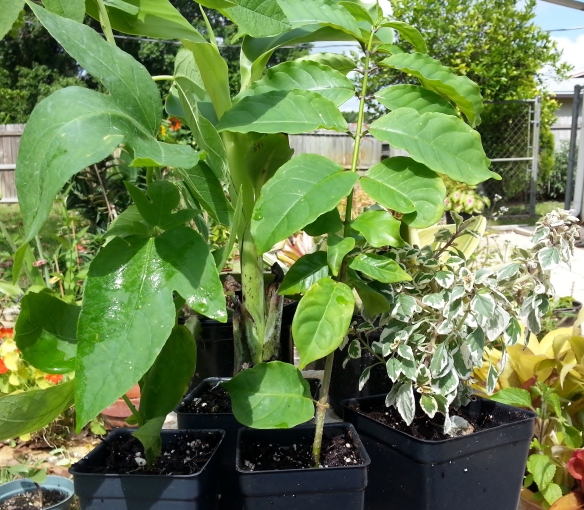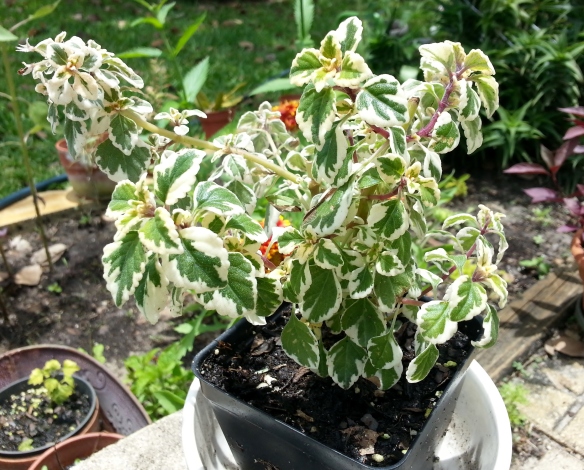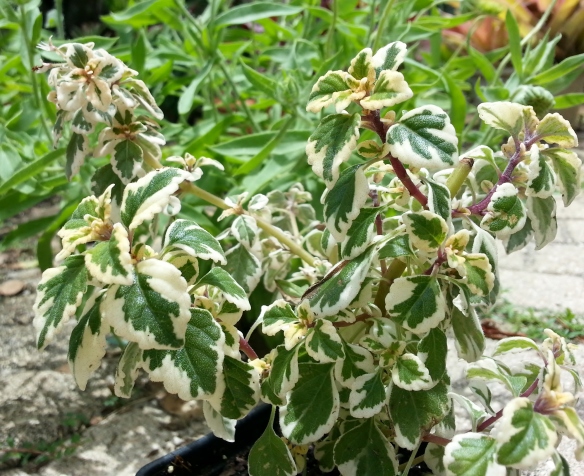I’ve had fairly good luck ordering plants via online retailers but this group from Logees Greenhouses seriously impressed me. 🙂
Logees’ speedy delivery (9 days from order to doorstep!) and careful packaging are also worth praising. The above photo was taken immediately after I unwrapped each little pot. Look at the dark, moist soil. Amazing, yeah? And not a speck out of place. 🙂
Whenever I receive new plants, I google the bejesus out of them to ensure I site them properly. No problem finding info on the Lady Margaret (red) passionflower or S. Preussii, an African liana with unusual medusa flowers. Big problem researching this one though:
Logees had it listed as “Hemizygia Candy Kisses”…argh!!! Half scientific/half common names make me absolutely bonkers, so I began looking for something more accurate. What I found surprised me!
In 2006, DNA sequencing revealed plants previously placed in the hemizygia genus shared a common evolutionary ancestor with those in the syncolostemon genus. Because this common ancestor was NOT shared by any other plant group, all involved were reclassified as Syncolostemons ➡ big Latin word for minty sagebushes. 🙂 If you’re still following, H. Candy Kisses is now S. Transvaalensis, the variety name given as a nod to its native African region.
All science aside, my new little shrub should be quite pretty! Mature height is 2 to 3ft with width about the same. When it blooms, purple/pink flowers will spike high above the foliage.
Despite its small size, S. transvaalensis is well adapted to rebounding from (brief) hard freezes or scorching fires due to a starchy swelling of its root crown known as a lignotuber. The lignotuber contains buds from which new stems sprout and a sufficient store of nutrients to keep them growing until photosynthesis kicks in again. Pretty amazing stuff!!!
Before I close, one last close look at its reddish stems and somewhat waxy leaves:
Until next time…..
🙂 🙂 🙂
17 thoughts on “A little plant with a big name”
Comments are closed.




Ha…. talking about plant names can be so confusing, like for example Cymbidium orchids. There are too many cross bred varieties.
When I bought the plant, the tag said it was Hemizygia ‘Candy Kisses’. It was from Haar Nursery in Australia and it ‘was not’ labelled under Australian native plant.
I think that H. ‘Candy Kisses’ is a Syncolostemon hybrid. The problem is that some nurseries create fancy names for hybridised plants to attract buyers:)
you are SO right Lois! Also, if I had a nickel for every mislabeled plant I purchased over the years, i’d be writing this reply from a million dollar home in the Caribbean instead of the tiny counter in my tiny house!
🙂
The correct name should be: Syncolostemon transvaalensis ‘Candy Kisses’. Should include Candy Kisses as it is the cultivar’s / hybrid name. Do you know that there is another hybrid of this plant called ‘Pink Candy’ ? I think this one is not variegated, but it also has pretty pink flowers.
Apparently, Hemizgya was regarded as ‘correct’ name until recently when the Botanists decided to change it into Syncolostemon. As for the smell of this plant, the one that I have smells slightly like sage and it is not minty at all.
Ooooppps…. Hemizygia, not Hemizgya (my comment below)… perhaps I am the one that really confused. LOL
That plant is a beauty. I like variegated plants in much the same way that I like variegated yarn.
variegated is definitely cool! re: yarn…you may not be old enough to recall the mohair sweater craze of the mid 1960s but I remember begging my mother for a variegated blue one I saw at Jordan Marsh (now Macy’s. That beauty has stuck in my mind all these years!!!)
Back to the shrub… I like how the new leaves start off cream-toned and then whiten up as they enlarge. The flowers should be quite interesting too, although I may not see them for awhile. 🙂
They are beautiful and indeed quite praise worthy…May your garden be blessed with good luck.
So it smells of mint and sage?
the leaves are minty smelling when you crack them, yes! Love that!
Lovely! I love your research, too. Leave it to you to get to the bottom of it, and enlighten us all…thank you!
Thanks Cindy!
I hope you have a great Memorial Day! Anything fun planned?
DNA sequencing seems to be turning things upside down. I just read that Meconopsis cambrica (Welsh poppy) isn’t related to Meconopsis after all, but rather to the Papavers. What’s a humble gardener to do?
it really is hard to keep up with the science…esp for people like me who don’t really have much in the way of a science background.
I hadn’t known about the re-categorizing of welsh poppies. Now you’ve given me something to look into this afternoon! 😉
The names always confuse me. And just now I’m unhappy with my pollen-induced allergies being worse than I can ever remember. Why can’t all flowering plants have pollinators instead of relying on the wind???
allergies are the WORST! I had terrible allergies to pollen in my teens through thirties…then for some unknown reason pollen stopped bothering me! I hope the same thing happens to you. 🙂
More amazing stuff: That someone can have so much knowledge about plants, which are an endless source of mystery to me. I still love them, though, Latin names and all.